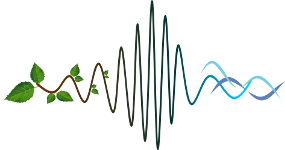Ecological characteristics that affect acoustic communication should shape acoustic signalling. In particular, information transfer between individuals needs to be adapted to the species social requirements and to ecological fluctuations. Environmental fluctuations in coastal and estuarine habitats include variations in the soundscape, tidal level, cyclic variations in turbidity, temperature, diel fluctuations, etc, which affect biological rhythms as well as signal transmission and degradation. Animals must cope with these fluctuations through physiological and behavioural adaptations. The Lusitanian toadfish males form breeding aggregations in coastal waters and use acoustic signals to advertise their presence, engage in interactions with other males, and attract females to their nests. We used round-the-clock sound recordings to monitor vocal activity in three locations in a natural habitat in the Tagus estuary (Portugal): intertidal nests only exposed in spring tides, subtidal nests (minimum 0.3 m water level) and infratidal areas (minimum 2.5 m water level). Individual vocal activity was quantified with an automatic pattern recognition methodology based on the Hidden Markov Model which allowed accurate detection and recognition of fish vocalizations. We investigated the relation of the vocal activity pattern with habitat parameters such as water level, temperature, light fluctuations and ambient noise. Ambient noise varied with changes of tide and currents but the main factor affecting underwater noise was human-related activity, such as the passage of small boat and ferry-boats. Toadfish vocal patterns were mainly affected by tide levels and only in intertidal/subtidal areas, as expected. Increased noise levels did not seem to cause consistent changes in vocal activity in breeding males. The influence of environmental and anthropogenic factors on fish social systems and reproductive success are discussed.
|
|
|
|
Wednesday
18
Methods IV
› 14:30 - 14:45 (15min) › Grande Galerie Evolution Conference Hall
The ecology of acoustic signalling in breeding Lusitanian toadfish (Halobatrachus didactylus) males: influence of environmental fluctuations and boat noise
1 : Instituto Superior de Psicologia Aplicada, Instituto Universitário
(ISPA)
-
Website
Rua Jardim do Tabaco 34, 1149-041 Lisboa -
Portugal
2 : Departamento de Biologia Animal and Centro de Biologia Ambiental, Faculdade de Ciências da Universidade de Lisboa.
(FCUL)
Faculdade de Ciências, Universidade de Lisboa. Bloco C2. Campo Grande, 1749-016 Lisboa, Portugal -
Portugal
3 : Departamento de Informática, Faculdade de Ciências, Universidade de Lisboa
(FCUL)
Departamento de Informática, Faculdade de Ciências, Universidade de Lisboa, Campo Grande 1749-016 Lisboa, Portugal -
Portugal
4 : Departamento de Biologia Animal and Centro de Biologia Ambiental, Faculdade de Ciências da Universidade de Lisboa.
(FCUL)
-
Website
* : Corresponding author
Departamento de Biologia Animal and Centro de Biologia Ambiental, Faculdade de Ciências, Universidade de Lisboa. Bloco C2. Campo Grande, 1749-016 Lisboa, Portugal -
Portugal
|
| Online user: 1 | RSS Feed |

|

 PDF version
PDF version